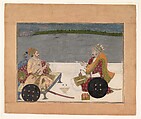Prince Padam Singh of Bikaner with His Bard Gordhar on a Terrace at Night
Attributed to Bhavani Das Indian
or his son Dalchand Indian
Not on view
The Kishangarh school of painting emerged in the early eighteenth century, likely stimulated by a surplus of Mughal atelier-trained artists who were seeking employment at the time of the accession of Muhammad Shah in Delhi. Initially the Kishangarh court style emulated that of contemporaneous Mughal production, but under the inspired directorship of the painter Bhavani Das, who arrived at the court from Delhi in 1719, it quickly assumed a distinctive character. The early Kishangarh school flourished under Bhavani Das and his son Dalchand. This work is unsigned but such is its skill in capturing individual physiognomies and the psychological interplay between the two figures that it may confidently be assigned to either Bhavani Das or Dalchand. It is inscribed on the reverse in both Hindi and Persian, naming the two figures, and characterizing Gordhar as “a singer of good songs.” The scene is set on a palace terrace with a low white marble balustrade, overlooking a silvered lake in the afterglow of an early evening.
Due to rights restrictions, this image cannot be enlarged, viewed at full screen, or downloaded.

